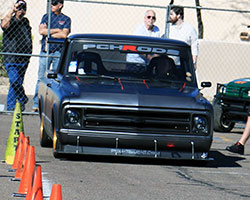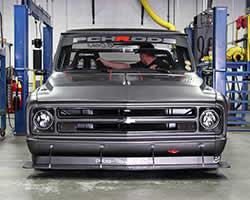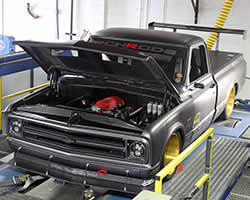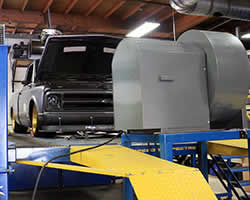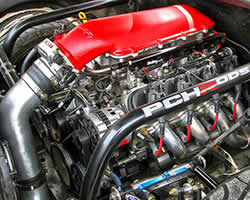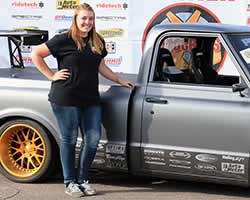1972 Chevy C10 R Dyno Tested At Last: PCH Rods Build with Spectre Equipment
- Aug 6, 2015
The 1972 Chevy C10 based C10R owned and driven by Rob & Brandy Phillips was over two years in the making before it made its debut at the 2014 Specialty Equipment Market Association (SEMA) at the Las Vegas Convention Center in Las Vegas, Nevada. The goal for the C10R was to keep it from becoming a full blown race car, but still be able to hang with the top competitors on the Autocross race circuit. A tried and true Chevrolet LS1 iron block engine was chosen to power the C10R truck but with the modifications Rob Phillips made he estimated the engine at around 585 horsepower with 575 lb-ft of torque.
Following a few shake down runs, the PCH Rods 1972 Chevy C10 R successfully made its debut at the 2014 SEMA show and earned an invitation to the Optima Ultimate Street Car Invitational held at Las Vegas Motor Speedway. Following the OUSCI Brandy headed to the Goodguys Autocross event, the first time in three years after becoming a mother, for the Goodguys 6th Spring Nationals presented by Brown’s Classic Autos in Scottsdale, Arizona. There Brandy was technically 5 seconds faster than her closest competitor in the truck class taking the win and moving into the Goodguys Autocross Pro Class.
Autocross is a timed competition in which drivers navigate one at a time typically through a short and technical course. This means that sheer power isn’t going to be the deciding factor in winning races. Having the right combination of suspension, wheels, tires, brakes, usable power, and driver technique tends to be far more effective than mind blowing amounts of power. However, as a true car guy Rob Phillips continued to have the question of how much horsepower the C10R LS1 engine makes nagging at him. To estimate power output is one thing, but to actually have numbers from a dyno test gives credibility. So at long last Rob and Brandy brought their 1972 Chevrolet C10 based C10R race truck by the Spectre Performance facility to strap it onto the dyno. After carefully unloading the truck from their enclosed trailer Rob fueled with standard pump gas. At the push of a button the Chevrolet LS1 V8 engine roared to life and Rob backed the C10R onto the Spectre Performance dyno for the moment of truth. With the truck securely strapped down, the hood up, and fans blowing it was time to see what the PCH Rods built Chevrolet LS1 engine was made of.
Even before knowing the final numbers it was evident the Chevy LS1 was well built. The engine spun up to a nearly 6,500 RPM rev limit at which time the engine was screaming. The exhaust note emitted from the NASCAR inspired low profile side exhaust was enough to get any American muscle car fan’s blood pumping. When the runs were complete it was determined that the PCH Rods built Spectre Performance intake equipped 1972 Chevy C10R maxed out at 400.3 horsepower and 354.2 lb-ft of torque at the rear wheels. The Chevy LS1 engine was built as a race engine with the meat of the horsepower curve coming on strong at nearly 6,000 RPM and continuing until redline. Peak torque hits just a shade lower in the RPM range making for very predictable and usable power.
Most vehicle manufacturers estimate horsepower at the crank, not at the wheels. It’s estimated that around 20% of the engine’s power is lost as it is transferred through the transmission, driveshaft, differential and finally to the wheels. Using a 20% drivetrain loss due as a rule of thumb this puts the Chevy C10R LS1 engine at over 500 horsepower and 425 lb-ft of torque at the crank. Considering the variances found between dyno manufacturers, and knowing that this particular dyno is more conservative than others, Rob believes that crank horsepower would be rated closer to 515 up to 525 HP. These are pretty good numbers for an iron block Chevrolet push-rod engine running pump gas and easily, not to mention fully legally, driven on the street.
Since 1983 Spectre Performance has designed and offered unique, innovative, parts and components to fuel your car or truck obsession. Spectre makes a wide array of air intake systems, air intake components and engine accessories just to name a few of the popular product categories. Whether your fixation happens to be a classic muscle car or a late model pickup truck, Spectre will help fuel your passion for performance. Browse all Spectre automotive products by category at SpectrePerformance.com. While you are there use the Products by Vehicle Search to find Spectre performance products specifically made for your vehicle. To find a Spectre dealer near you use the Spectre Dealer Locator. |
||||||

